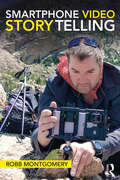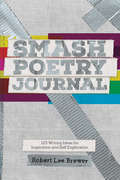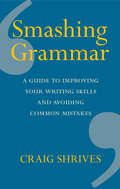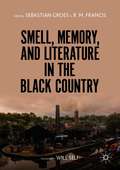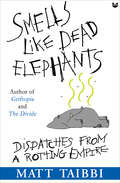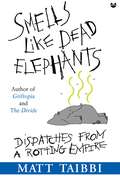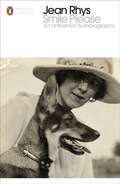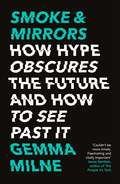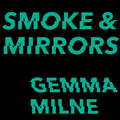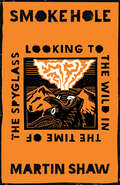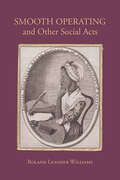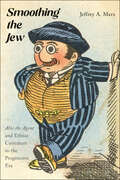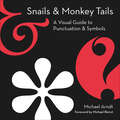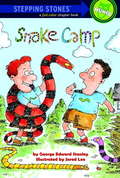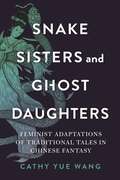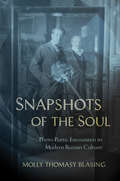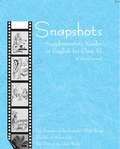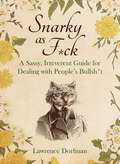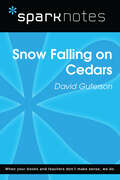- Table View
- List View
Smartphone Communication: Interactions in the App Ecosystem (Routledge Studies in New Media and Cyberculture)
by Francisco YusThis book offers a unique model for understanding the cognitive underpinnings, interactions and discursive effects of our evolving use of smartphones in everyday app-mediated communication, from text messages and GIFs to images, video and social media apps. Adopting a cyberpragmatics framework, grounded in cognitive pragmatics and relevance theory, it gives attention to how both the particular interfaces of different apps and users’ personal attributes influence the contexts and uses of smartphone communication. The communication of emotions – in addition to primarily linguistic content – is foregrounded as an essential element of the kinds of ever-present paralinguistic and phatic communication that characterises our exchange of memes, GIFs, "likes," and image- and video-based content. Insights from related disciplines such as media studies and sociology are incorporated as the author unpacks the timeliest questions of our digitally mediated age. Aimed primarily at scholars and graduate students of communication, linguistics, pragmatics, media studies, and sociology of mass media, Smartphone Communication traffics in topics that will likewise engage upper-level undergraduate students.
Smartphone Video Storytelling
by Robb MontgomerySmartphone Video Storytelling helps readers master the techniques for making compelling short-form video content with a smartphone. With mobile journalism on the rise, it’s becoming increasingly important to understand the entire process and potential for conveying stories across multiple platforms. This richly illustrated text provides students with the essential smartphone video reporting skills: From choosing the right editing app to working with interview subjects on camera. The ethics of non-fiction video storytelling are highlighted to reinforce core journalistic principles. The chapters feature mini-tutorials and exercises that introduce the key principles of filmmaking. The student exercises and library of online video lessons introduce the building blocks of visual storytelling using real-world reporting examples. A story-based approach allows instructors to use the experiences of making each project in order to teach the fundamentals of video storytelling in a natural way. Each story lesson introduces the necessary stages, including planning, filming, and editing . . . and all with a smartphone. Online example videos can be found at http://smartfilmbook.com/
Smash Poetry Journal: 125 Writing Ideas for Inspiration and Self Exploration
by Robert Lee BrewerA Poetry Journal to Poem Your Days Away! Don't wait for inspiration to strike! Whether you're an aspiring or published poet, this book will help you get in a frame of mind to make creative writing a consistent part of your life. With prompts from Robert Lee Brewer's popular Writer's Digest blog, Poetic Asides, you'll find 125 ideas for writing poems along with the journaling space you need to respond to the prompt.125 unexpected poetry prompts such as from the perspective of an insect, about a struggle, or including the word changePlenty of blank space to compose your own poemsTips on unique poetic forms and other poetry resourcesPerfectly sized to carry in a backpack or purse, you can jot down ideas for poems as you're waiting in line for a morning coffee or take it to the park for a breezy afternoon writing session. Wherever you are, your next poem is never more than a page-turn away.
Smashing Grammar: A guide to improving your writing skills and avoiding common mistakes
by Craig Shrives'Few people understand Grammar like Craig Shrives. Best of all, no one explains it so well and so easily.' - Chief Executive of Crimestoppers and former Director of the Intelligence Corps, Mark Hallas OBE Written by a former British Army officer (also the founder of the popular website Grammar Monster), Smashing Grammar is both a go-to grammar guide and a primer for writing clear English.Smashing Grammar is divided into three sections: A-Z of Punctuation, A-Z of Grammar Essentials and A-Z of Easily Confused Words. Every entry starts with a simple explanation and some basic examples. These are followed by real-life, engaging examples, which have been painstakingly hunted down for their ability to illustrate the point.Every entry concludes with a 'Why Should I Care?' section offering great tips and advice and explaining why the grammar point matters to a writer. Imbued with 'barrack room' humour, the writing itself is entertaining and often laugh-out-loud funny, with thousands of sample quotations ranging from Groucho Marx and Homer the Simpson to Karl Marx and Homer the Greek.
Smell, Memory, and Literature in the Black Country
by Sebastian Groes R. M. FrancisFrom Banks’s brewery’s yeasty stink to groaty pudding to spicy curry, Sebastian Groes and R. M. Francis have assembled a new literary history of the smells and (childhood) memories that belong to the Black Country. This often overlooked region of the United Kingdom at the frontlines of post-industrial upheaval is a veritable treasure trove for studying the relationship between olfaction and place-specific memory. Smell, Memory, and Literature in the Black Country is an interdisciplinary exploration of the relationship between smell and memory in which the contributions consider both personal and communal memory. Drawing on psychology, neuroscience, memory studies, literary studies and philosophy, the critical essays reconsider psychogeography through cutting-edge sensory and philosophical engagements with physical space, smell, language and human behaviour. The creative contributions from writers including Liz Berry, Narinder Dhami, Anthony Cartwright, and Kerry Hadley-Pryce meditate on the senses, place, and identity. Not only does this book illustrate the rich cultural heritage of the Black Country, it will also appeal to those interested in place writing. The book is prefaced by Will Self.
Smells Like Dead Elephants: Dispatches from a Rotting Empire
by Matt TaibbiSmells Like Dead Elephants is a brilliant collection from Matt Taibbi, a political reporter with the gonzo spirit that made Hunter S. Thompson and P. J. O’Rourke so much fun” (The Washington Post). Bringing together Taibbi’s most incisive and hilarious work from his Road Work” column in Rolling Stone, Smells Like Dead Elephants shines an unflinching spotlight on the corruption, dishonesty, and sheer laziness of our leaders. Taibbi has plenty to say about George W. Bush, Jack Abramoff, Tom DeLay, and all the rest, but he doesn’t just hit inside the Beltway. He gets involved in the action, infiltrating Senator Conrad Burns’s birthday party under disguise as a lobbyist for a fictional oil firm that wants to drill in the Grand Canyon. He floats into apocalyptic post-Katrina New Orleans in a dinghy with Sean Penn. He goes to Iraq as an embedded reporter, where he witnesses the mind-boggling dysfunction of our occupation and spends three nights in Abu Ghraib prison. And he reports from two of the most bizarre and telling trials in recent memory: California v. Michael Jackson and the evolution-vs.-intelligent-design trial in Harrisburg, Pennsylvania. Equally funny and shocking, this is excellent work from one of our most entertaining writers.
Smells like Dead Elephants: Dispatches from a Rotting Empire
by Matt TaibbiMatt Taibbi is notorious as a journalistic agitator, a stone thrower, a "natural provocateur" (Salon. com). His scathing, vibrant prose shines an unflinching spotlight on the corruption, dishonesty, and sheer laziness of our leaders. Smells Like Dead Elephants brings together Taibbi's most incisive, intense, and hilarious work from his "Road Work" column in Rolling Stone. Written over the last two years, a period in our history with no shortage of outrages to compel Taibbi's pen, these pieces paint a shocking portrait of our government at work--or, as Taibbi points out in "The Worst Congress Ever," rarely working. "In the Sixties and Seventies, Congress met an average of 162 days a year. The 109th Congress set the all-time record for fewest days worked by a U.S. Congress: 93. Figuring for half-days, in fact, the 109th Congress probably worked almost two months less than the notorious 'Do-Nothing' Congress of 1948". Taibbi has plenty to say about George W. Bush, Jack Abramoff, Tom DeLay, and all the rest, but he doesn't just hit inside the Beltway. He gets involved in the action, infiltrating Senator Conrad Burns's birthday party under disguise as a lobbyist for a fictional oil firm that wants to drill in the Grand Canyon. He floats into apocalyptic post-Katrina New Orleans in a dinghy with Sean Penn. He goes to Iraq as an embedded reporter, where he witnesses the mind-boggling dysfunction of our occupation and spends three nights in Abu Ghraib prison. And he reports from two of the most bizarre and telling trials in recent memory: California v. Michael Jackson and the evolution-vs.-intelligent-design trial in Harrisburg, Pennsylvania. A brilliant collection from one of the most entertaining political writers of today, Smells Like Dead Elephants is a stylish record of the offenses of the Bush years.
Smiley. Herzchen. Hashtag.: Zwischenmenschliche Kommunikation im Zeitalter von Facebook, WhatsApp, Instagram @ Co. (Über/Strom: Wegweiser durchs digitale Zeitalter)
by Uta ButtkewitzLieber eine schnelle Sprachnachricht als ein persönlicher Anruf, ein Smiley statt eines Grußes – die Kommunikation verändert sich im digitalen Zeitalter. Kommunikation wird unverbindlich, aber gleichzeitig steigt der Kommunikationsdruck durch soziale Medien und Netzwerke. Wir stehen unter Druck, jederzeit schnell zu kommunizieren. In Ruhe einen Kaffee trinken, die Aussicht genießen? Geht nicht, jede WhatsApp muss umgehend beantwortet werden und die Likes unter dem Foto zählen mehr als der Genuss des Augenblicks. Viel zu kurz kommt bei all dem die zwischenmenschliche Kommunikation.Dieses Buch zeigt, wie aktuelle Kommunikationsmedien wie WhatsApp, Facebook oder Instagram die zwischenmenschliche Kommunikation beeinflussen und wie diese Veränderungen unsere Beziehungen und unser gesellschaftliches Zusammenleben schleichend verändern. Die Verfügbarkeit einer Vielzahl von Medien stellt uns vor große Herausforderungen. Wenn Sie sich schon immer gefragt haben, warum das Kommunizieren im Privat- oder Berufsleben plötzlich schwieriger geworden ist, finden Sie in diesem Buch Antworten darauf. Sie lernen, wie Sie im digitalen Zeitalter bei sich bleiben und sich nicht von kurzfristigen Erregungszuständen der Medien aus dem Gleichgewicht bringen lassen. Treffen Sie bewusste Entscheidungen für Medien und ihre Nutzung und erobern Sie Ihre kommunikative Selbstbestimmung zurück!
Smoke & Mirrors: How Hype Obscures the Future and How to See Past It
by Gemma Milne'Stop following the news until you've read Gemma Milne's persuasive analysis of the hype and bullshit that distort our understanding of emerging science. As she shows, the starting point to grasping the genuine opportunities of AI, life sciences and climate tech is a healthy dose of critical thinking'David Rowan, founding editor of WIRED UK and author of Non-Bullshit Innovation: Radical Ideas from the World's Smartest Minds'Couldn't be more timely. Fascinating and vitally important'Jamie Bartlett, author of The People Vs Tech'A much-needed blast of fresh air! Gemma Milne expertly shows us how to separate the truth from the hype surrounding the emerging techs of today, and those of the near-tomorrow'Lewis Dartnell, author of Origins: How the Earth Made Us'I loved this book! This is exactly the sort of sceptical, cut-through-the crap-but-still-excited-about-what's-emerging book around tech innovation that's sorely needed, yet is so hard to find . . . essential reading for anyone who's serious about how real-world advances might be effectively harnessed to build a better future'Dr Andrew Maynard, scientist and author of Films from the Future and Future Rising'[A] vital contribution in a world where technological progress promises so much, but too often disappoints. If, like me, you believe that advances in science and technology are our best hope for solving the grand challenges of our times, this book is the indispensable guide to avoiding the mirages and the charlatans along the way'Matt Clifford, co-founder and CEO of Entrepreneur First'A refreshingly grown-up, clear-headed look at the interaction between science, technology and the media - readable without being dumbed down, acknowledging complexities without being heavy'Tom Chivers, author of The AI Does Not Hate You'ROBOTS WILL STEAL YOUR JOB!''AI WILL REVOLUTIONISE FARMING!''GENETIC EDITING WILL CURE CANCER!'Bombastic headlines about science and technology are nothing new. To cut through the constant stream of information and misinformation on social media, or grab the attention of investors, or convince governments to take notice, strident headlines or bold claims seem necessary to give complex, nuanced information some wow factor.But hype has a dark side, too.It can mislead. It can distract. It can blinker us from seeing what is actually going on.From AI, quantum computing and brain implants, to cancer drugs, future foods and fusion energy, science and technology journalist Gemma Milne reveals hype to be responsible for fundamentally misdirecting or even derailing crucial progress.Hype can be combated and discounted, though, if you're able to see exactly where, how and why it is being deployed.This book is your guide to doing just that.
Smoke & Mirrors: How Hype Obscures the Future and How to See Past It
by Gemma Milne'Stop following the news until you've read Gemma Milne's persuasive analysis of the hype and bullshit that distort our understanding of emerging science. As she shows, the starting point to grasping the genuine opportunities of AI, life sciences and climate tech is a healthy dose of critical thinking'David Rowan, founding editor of WIRED UK and author of Non-Bullshit Innovation: Radical Ideas from the World's Smartest Minds'Couldn't be more timely. Fascinating and vitally important'Jamie Bartlett, author of The People Vs Tech'A much-needed blast of fresh air! Gemma Milne expertly shows us how to separate the truth from the hype surrounding the emerging techs of today, and those of the near-tomorrow'Lewis Dartnell, author of Origins: How the Earth Made Us'I loved this book! This is exactly the sort of sceptical, cut-through-the crap-but-still-excited-about-what's-emerging book around tech innovation that's sorely needed, yet is so hard to find . . . essential reading for anyone who's serious about how real-world advances might be effectively harnessed to build a better future'Dr Andrew Maynard, scientist and author of Films from the Future and Future Rising'[A] vital contribution in a world where technological progress promises so much, but too often disappoints. If, like me, you believe that advances in science and technology are our best hope for solving the grand challenges of our times, this book is the indispensable guide to avoiding the mirages and the charlatans along the way'Matt Clifford, co-founder and CEO of Entrepreneur First'A refreshingly grown-up, clear-headed look at the interaction between science, technology and the media - readable without being dumbed down, acknowledging complexities without being heavy'Tom Chivers, author of The AI Does Not Hate You'ROBOTS WILL STEAL YOUR JOB!''AI WILL REVOLUTIONISE FARMING!''GENETIC EDITING WILL CURE CANCER!'Bombastic headlines about science and technology are nothing new. To cut through the constant stream of information and misinformation on social media, or grab the attention of investors, or convince governments to take notice, strident headlines or bold claims seem necessary to give complex, nuanced information some wow factor.But hype has a dark side, too.It can mislead. It can distract. It can blinker us from seeing what is actually going on.From AI, quantum computing and brain implants, to cancer drugs, future foods and fusion energy, science and technology journalist Gemma Milne reveals hype to be responsible for fundamentally misdirecting or even derailing crucial progress.Hype can be combated and discounted, though, if you're able to see exactly where, how and why it is being deployed.This book is your guide to doing just that.
Smoke & Mirrors: How Hype Obscures the Future and How to See Past It
by Gemma Milne'Stop following the news until you've read Gemma Milne's persuasive analysis of the hype and bullshit that distort our understanding of emerging science. As she shows, the starting point to grasping the genuine opportunities of AI, life sciences and climate tech is a healthy dose of critical thinking'David Rowan, founding editor of WIRED UK and author of Non-Bullshit Innovation: Radical Ideas from the World's Smartest Minds'Couldn't be more timely. Fascinating and vitally important'Jamie Bartlett, author of The People Vs Tech'A much-needed blast of fresh air! Gemma Milne expertly shows us how to separate the truth from the hype surrounding the emerging techs of today, and those of the near-tomorrow'Lewis Dartnell, author of Origins: How the Earth Made Us'I loved this book! This is exactly the sort of sceptical, cut-through-the crap-but-still-excited-about-what's-emerging book around tech innovation that's sorely needed, yet is so hard to find . . . essential reading for anyone who's serious about how real-world advances might be effectively harnessed to build a better future'Dr Andrew Maynard, scientist and author of Films from the Future and Future Rising'[A] vital contribution in a world where technological progress promises so much, but too often disappoints. If, like me, you believe that advances in science and technology are our best hope for solving the grand challenges of our times, this book is the indispensable guide to avoiding the mirages and the charlatans along the way'Matt Clifford, co-founder and CEO of Entrepreneur First'A refreshingly grown-up, clear-headed look at the interaction between science, technology and the media - readable without being dumbed down, acknowledging complexities without being heavy'Tom Chivers, author of The AI Does Not Hate You'ROBOTS WILL STEAL YOUR JOB!''AI WILL REVOLUTIONISE FARMING!''GENETIC EDITING WILL CURE CANCER!'Bombastic headlines about science and technology are nothing new. To cut through the constant stream of information and misinformation on social media, or grab the attention of investors, or convince governments to take notice, strident headlines or bold claims seem necessary to give complex, nuanced information some wow factor.But hype has a dark side, too.It can mislead. It can distract. It can blinker us from seeing what is actually going on.From AI, quantum computing and brain implants, to cancer drugs, future foods and fusion energy, science and technology journalist Gemma Milne reveals hype to be responsible for fundamentally misdirecting or even derailing crucial progress.Hype can be combated and discounted, though, if you're able to see exactly where, how and why it is being deployed.This book is your guide to doing just that.
Smoke Hole: Looking to the Wild in the Time of the Spyglass
by Martin Shaw"With potent, lyrical language and a profound knowledge of storytelling, Shaw encourages and illuminates the mythic in our own lives. He is a modern-day bard." – Madeline Miller, author of Circe and The Song of Achilles At a time when we are all confronted by not one, but many crossroads in our modern lives—identity, technology, trust, politics, and a global pandemic—celebrated mythologist and wilderness guide Martin Shaw delivers Smoke Hole: three metaphors to help us understand our world, one that is assailed by the seductive promises of social media and shadowed by a health crisis that has brought loneliness and isolation to an all-time high. Smoke Hole is a passionate call to arms and an invitation to use these stories to face the complexities of contemporary life, from fake news, parenthood, climate crises, addictive technology and more. Shaw urges us to reclaim our imagination and untangle ourselves from modern menace, letting these tales be our guide. More Praise: "I can still remember the first time I heard Martin Shaw tell a story. The tale that emerged was like a living thing, bounding around, throwing itself at us there listening. I had never heard anything like it before." – Paul Kingsnorth, Booker shortlisted author of The Wake "Martin Shaw’s work is so very beautiful. A new animal. His love of images is deep and contagious." – Coleman Barks, author of The Essential Rumi "Through feral tales and poetic exegesis, Martin Shaw makes you re-see the world, as a place of adventure, and of initiation, as perfect home, and as perfectly other. What a gift." – David Keenan, author of Xstabeth "Shaw has so much wisdom and knowledge about the old stories, it emanates from his pores." – John Densmore, The Doors
Smoke Hole: Looking to the Wild in the Time of the Spyglass
by Martin Shaw"A modern-day bard."—Madeline Miller, author of Circe and The Song of Achilles"Shaw has so much wisdom and knowledge about the old stories, it emanates from his pores."—John Densmore, The Doors"Through feral tales and poetic exegesis, Martin Shaw makes you re-see the world, as a place of adventure and of initiation, as perfect home and as perfectly other. What a gift."—David Keenan, author of Xstabeth"I can still remember the first time I heard Martin Shaw tell a story. The tale that emerged was like a living thing, bounding around, throwing itself at us there listening. I had never heard anything like it before."—Paul Kingsnorth, Booker shortlisted author of The WakeToday, as we are confronted by not one, but many crossroads in our lives – identity, technology, love, seduction, politics – celebrated mythologist and wilderness guide Martin Shaw delivers Smoke Hole – three ancient myths that serve as metaphors for our world today. Assailed by the seductive promises of social media and shadowed by a pandemic that brought loneliness to an all-time high, Martin argues that we are losing our sense of direction, our sense of self.He invites us to use these stories to help find &‘a commons for the imagination, a place to breathe deeper, feel steadier and become acquainted with rapture.&’ Smoke Hole is a passionate call to arms and an invitation to use these stories to face the complexities of contemporary life, from fake news to parenthood, climate crises, addictive technology and more.
Smooth Operating and Other Social Acts: Smooth Operating And Other Social Acts (SUNY series in Multiethnic Literatures)
by Roland Leander WilliamsThrough a cultural study of writings about slavery in the United States, Smooth Operating and Other Social Acts uncovers a mode of behavior adopted by African Americans for relief from the brutality of black bondage. Roland Leander Williams grants that African Americans have been beaten, but he guarantees that they have not been broken. While he acknowledges that they have been demeaned, he assures that they have not been diminished. Williams confesses that African Americans have been done harm, but he confirms that they have not become disheartened. Close readings of classic slave narratives, along with some neo-slave narratives—including The Conjure Woman (1899), Kindred (1979), Dessa Rose (1986), and The Good Lord Bird (2013)—furnish proof that African Americans have preserved their dignity and elevated their status through ingenious applications of improvisation. Smooth Operating and Other Social Acts establishes as well that a dim view of African Americans, propagated by black bondage, bears a resemblance to sexual discrimination, which prompts female targets of its gaze to practice dissembling.
Smoothing the Jew: "Abie the Agent" and Ethnic Caricature in the Progressive Era
by Jeffrey A. MarxThe turn of the nineteenth century in the United States saw the substantial influx of immigrants and a corresponding increase in anti-immigration and nativist tendencies among longer-settled Americans. Jewish immigrants were often the object of such animosity, being at once the object of admiration and anxiety for their perceived economic and social successes. One result was their frequent depiction in derogatory caricatures on the stage and in print. Smoothing the Jew investigates how Jewish artists of the time attempted to “smooth over” these demeaning portrayals by focusing on the first Jewish comic strip published in English, Harry Hershfield’s Abie the Agent. Jeffrey Marx demonstrates how Hershfield created a Jewish protagonist who in part reassured nativists of the Jews’ ability to assimilate into American society while also encouraging immigrants and their children that, over time, they would be able to adopt American customs without losing their distinctly Jewish identity.
Snails & Monkey Tails: A Visual Guide to Punctuation & Symbols
by Michael Arndt"There are countless books that can teach you the alphabet, but almost none that focus on the tiny designs that run interference among the letterforms: those easily overlooked punctuation and typographic symbols. These symbols, as Michael Arndt proves in this beautiful and endlessly fascinating book, are absolutely indispensable to communication: punctuation turns words into sentences and language into meaning... From commas to semicolons, from slashes to asterisks, from guillemets to octothorpes (named, perhaps, after athlete Jim Thorpe), you’ll never look at punctuation the same way again."—Michael Bierut, partner, PentagramIn this show-stopping guide with more than 75 uniquely designed two-color spreads—a rollicking linguistic ride for fans of Eats, Shoots & Leaves and Just My Type—award-winning graphic designer Michael Arndt explores the typographic origins, names, and shapes of both common punctuation marks and symbols, as well as the proper and diverse usage of each.From the period to the question mark, the semicolon to the em dash, symbols and marks are an integral part of language. In graphically engaging spreads that utilize typography in an innovative way, Snails & Monkey Tails examines the evolution of these mighty linguistic tools—from the punctum, or point, created by an ancient scribe to the guillemet, used most commonly in lieu of quote marks by the French (and named in honor of a typographer Guillaume Le Bé). With verve and insight, Michael Arndt explains their proper usage and how they came to be universally accepted today. Snails & Monkey Tails—Snails (@); Monkey Tails (&)—is packed with intriguing facts, history, stories, and lore, as well as grammar, explaining it clearly and with examples. What is the purpose of the comma—perhaps the most used symbol in the English language—and what are the proper uses of the asterisk? Do quote marks go inside or outside punctuation? What about a quote within a quote—a quote from someone quoting someone else? How much space goes on either side of an ellipsis? What’s the difference between an en-dash and an em-dash? Complete with a listing of useful terms and clear diagrams for creating typographical marks and symbols correctly on both PC and Apple computers, Snails & Monkey Tails is essential for bibliophiles, writers, grammarians, graphic designers, typography enthusiasts, logophiles, and anyone with a passion for the written word.
Snake Camp
by George E. StanleyStevie Marsh is off for the summer to learn about computers at Camp Viper. He's not happy about being in the woods with all the bugs and poison ivy and--yuck!--snakes. But how bad can computer camp be? Then Stevie finds out Camp Viper isn't a computer camp at all. The vipers at this camp are the kind that slither!
Snake Sisters and Ghost Daughters: Feminist Adaptations of Traditional Tales in Chinese Fantasy (The Donald Haase Series in Fairy-Tale Studies)
by Cathy Yue WangContemporary Chinese film and literature often draw on time-honored fantastical texts and tales which were founded in the milieu of patriarchy, parental authority, heteronormativity, nationalism, and anthropocentrism. Author Cathy Yue Wang examines the processes by which modern authors and filmmakers reshape these traditional tales to develop new narratives that interrogate the ingrained patriarchal paradigm. Through a rigorous analysis, Wang delineates changes in both content and narrative that allow contemporary interpretations to reimagine the gender politics and contexts of the tales retold. With a broad transmedia approach and a nuanced understanding of intertextuality, this work contributes to the ongoing negotiation in academic and popular discourse between past and present, traditional and contemporary, and text and reality in a globalized and postmodern world. Snake Sisters and Ghost Daughtersoffers an engaging interdisciplinary investigation of issues at the heart of these traditional tales such as gender and status hierarchy, marriage and family life, and in-group/out-group distinction. Beyond the content of these individual stories, Wang ties these narratives together across time using cognitive literary criticism, especially affective narratology, to shed new light on the adaptation of literary and cultural texts and their sociopolitical contexts.
Snakeskin Canyon
by Diana Kizlauskas Becky GoldThe fun and excitement of English and Language Arts learning continues in Grade 2 of Reading Street. This comprehensive and dynamic curriculum for homeschooling is geared toward young children who have some foundational English and Language Arts knowledge and are ready to strengthen their skills. Comprised of engaging activities, challenging content and weekly quizzes, Reading Street: Grade 2 is the next step in your child's path toward becoming a lifelong learner and reader. As with all Reading Street products, the Grade 2 system is formatted to help students meet certain age-appropriate goals. After completing this English and Language Arts homeschool program, your child should be able to: Read and comprehend two-syllable words. Identify common prefixes (such as pre-, un-, or re-) and suffixes (such as -able, -ad and -er). Correct mistakes made when reading out loud. Read books with two or more chapters. Understand the structure of stores (i. e. beginning, middle and end). Start selecting reading materials based on his/her own interests. Identify the "who," "what," "when," "where," "why" and "how" of the text. While the goals of second Grade English and Language Arts are numerous, Reading Street will help you craft engrossing lessons. Your child will garner important English and Language Arts skills while completing a workbook, reading stories and poems, and taking assessments. Planning these lessons will be easier than ever, as all Reading Street systems are broken down into weekly Big Ideas. All the work your child does on a given week is formulated around that single concept for an organized and challenging curriculum. With six easy-to-follow units, Reading Street: Grade 2 is the perfect tool for homeschooling parents. Your child will enjoy the reading selections and activities, and you'll love to see your student growing into a knowledgeable individual. We're confident that this product is the right one for you. For more information on the specific materials found in Grade 2 of Reading Street, check out the Features and Benefits page.
Snapshots of the Soul: Photo-Poetic Encounters in Modern Russian Culture
by Molly Thomasy BlasingSnapshots of the Soul considers how photography has shaped Russian poetry from the early twentieth century to the present day. Drawing on theories of the lyric and the elegy, the social history of technology, and little-known archival materials, Molly Thomasy Blasing offers close readings of poems by Boris Pasternak, Marina Tsvetaeva, Joseph Brodsky, and Bella Akhmadulina, as well as by the late and post-Soviet poets Andrei Sen-Sen'kov, Arkadii Dragomoshchenko, and Kirill Medvedev, to understand their fascination with the visual language, representational power, and metaphorical possibilities offered by the camera and the photographic image. Within the context of long-standing anxieties about the threat that visual media pose to literary culture, Blasing finds that these poets were attracted to the affinities and tensions that exist between the lyric or elegy and the snapshot. Snapshots of the Soul reveals that at the core of each poet's approach to "writing the photograph" is the urge to demonstrate the superior ability of poetic language to capture and convey human experience.Open Access edition funded by the National Endowment for the Humanities.
Snapshots: Supplementary Reader in English (Core Course) class 11 - NCERT - 23
by National Council of Educational Research and TrainingSnapshots is a supplementary reader for Class 11 English that contains a collection of short stories, biographical sketches, and poems. The stories deal with a range of human predicaments, such as moral choices in adolescents, the poignancy of personal loss and reconciliation that follows war, and professional commitment. The biographical sketches provide insights into the lives and works of some of the most influential people in history. The poems offer a variety of perspectives on the human condition. Snapshots is a valuable resource for students who are looking for challenging and thought-provoking literature.
Snarky As F*ck: A Sassy, Irreverant Guide for Dealing with People's Bullsh*t
by Lawrence DorfmanLearn how to become the most glorious a**shole the world has ever seen. Are you tired of everyone&’s bullsh*t? Responding to their dumba** questions? Making boring small talk and offering robotic replies? Can&’t take one more monotonous, people-pleasing conversation with a distant family member or a friend&’s friend? If you have no f*cks left to give and want to dish out some serious snark, grab a copy Snarky as F*ck, the premiere guide to all things sarcastic and sardonic. Explore topics such as: Sex and Romance (Responses to D*ck Pics, Mansplaining, and More) Geography (Snarkiest States in the US!) 21st Century Snark (Curse Word Definitions, Inspirational Bullsh*t, etc.) In the Workplace (Snarky Replies, Sotto Voce Things to Say to Your Boss) Family, Friends, and other Influencers (Greeting Cards for Bastards, and Insults for Around the Dinner Table!) Movies, Television, and Music (&“I&’m clapping because it&’s finished, not because I like it.&”) Politics and Government (Presidential Insults and Your New Favorite Game: Match the Scandal!) In the News (Florida Man, Karen and Brad, Idiots on Wheels, et al) Hear wit, sarcasm, and offhanded comments from masters like Dorothy Parker, Groucho Marx, H. L. Mencken, Oscar Wilde, Robert Benchley, George Bernard Shaw, Jules Feiffer, Bill Hicks, Bill Maher, Phyllis Diller, Édith Piaf, W. C. Fields, Mark Twain, Voltaire, Charles Bukowski, to name a few. This lofty tome promises to fulfill the need to chuckle, guffaw, titter, groan, and belly laugh as readers dip in and out of the great minds in literature, comedy, movies, music, and more. Proceed with caution, but know you&’ll come out the other side one snarky motherf*cker, ready to take on the world, one idiot at a time.
Snoopy's Book of Words
by Charles M. SchulzTeach your little ones about words and start building their vocabulary with the help of Snoopy and his pals.Snoopy's Book of Words is the perfect introduction for little ones to learn basic vocabulary words along with Snoopy and his Peanuts friends.
Snow Falling on Cedars (SparkNotes Literature Guide Series)
by SparkNotesSnow Falling on Cedars (SparkNotes Literature Guide) by David Guterson Making the reading experience fun! Created by Harvard students for students everywhere, SparkNotes is a new breed of study guide: smarter, better, faster. Geared to what today's students need to know, SparkNotes provides: *Chapter-by-chapter analysis *Explanations of key themes, motifs, and symbols *A review quiz and essay topicsLively and accessible, these guides are perfect for late-night studying and writing papers

